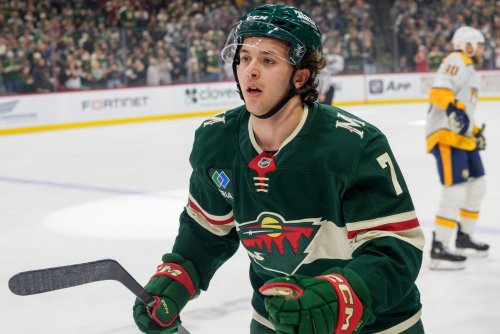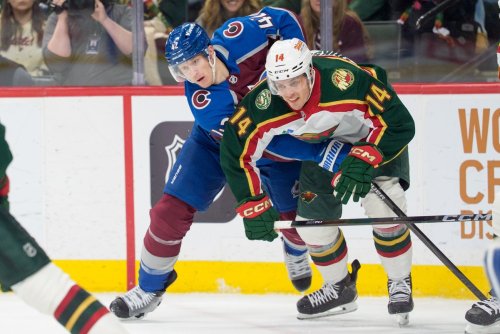
Do you feel lucky? Well, do you, punk Wild fans?
As Greguisition mentioned in his walk this morning, the Minnesota Wild currently hold the 11th spot in the draft, and have a slightly less than 10 percent chance of moving up into the top three. But what can we glean from history, and how often does something like this actually happen?
Before we jump into results, stats and lucky rabbit’s feet, some perspective. The NHL draft lottery has taken place every year since 1995, but the rules have changed significantly from its inception. From 1995 through 2012, only one team was selected in the lottery, and that team could only move up a total of four spots, meaning a team seeded sixth or below could technically “win” the lottery, but not earn the first overall pick. In 2013, all 14 non-playoff teams were made eligible for the number one pick, and in 2014, the NHL changed their weighted system, worsening the odds for the bottom four teams and offering better odds to the other 10 teams, essentially trying to eliminate end-of-season tanking for a better chance at a higher pick. Finally, in 2016, the NHL increased the number of lottery winners from one to three, giving opportunities for teams to move into the first, second and third overall positions. The NHL draft lottery has not changed since 2016, with the exception that odds of winning the lottery changed slightly with the addition of the Vegas Golden Knights.
So how likely is it that the Wild, or another low-seeded team defy the odds and move up?
Well, let’s start with the odds for the 2019 NHL Entry Draft (from tankathon):
A team’s total odds are calculated by adding up the possibilities for any kind of improvement. For the Wild, that equates to 9.9 percent. For Ottawa, the 31st ranked team in the standings, that equates to basically a coin flip at just below 50 percent — though their luck (or unluck) won’t benefit them, as Colorado owns Ottawa’s first round pick from the Matt Duchene trade.
Let’s take a look at the history of the NHL draft and some of the biggest movers to get a sense of what is possible, if we only believe hard enough:
The 2017 NHL Draft Lottery
We don’t have very far back to look to find examples of long-shots coming through in the ping pong ball hopper. All three teams that were chosen in the 2017 lottery were single-digit chances to earn those individual picks. New Jersey’s number one overall selection was an 8.5 percent chance (26 percent chance of improvement), Dallas’ third overall pick was the result of a 6.4 percent opportunity (18.3 percent total), but the Philadelphia Flyers gave every team hope, as they were able to snag a second overall pick with a mere 7.3 percent chance of moving up at all, and only 2.4 percent of the combinations to earn their spot. On the flip side, the Colorado Avalanche had a 48 percent chance of picking in the top three, and were relegated to fourth.
2018: Carolina Hurricanes
Last year’s draft was pretty chalky (Buffalo won the lottery in the No. 1 position, and Montreal moved up a single spot from fourth to third), with one notable exception. The Carolina Hurricanes won the second overall pick in the exact same spot that the Wild sit this year, with a 9.9 percent overall chance of improvement and a 3.3 percent chance of earning their pick. So if you’re looking for a massive Wild improvement in draft status, there’s what you’re banking on.
2011: New Jersey Devils
The Devils hit on a 3.6 percent chance to move from the eighth pick to the fourth, selecting defenseman Adam Larsson.
2007: Chicago Blackhawks
What would Patrick Kane have looked like in orange and black? We’ll never know, as the Chicago Blackhawks won the draft lottery in 2007, earning the team’s first-ever number one overall pick with only an 8.1 percent chance, selecting the face of their franchise for the next decade. Philadelphia’s consolation prize was James van Riemsdyk.
1999-2004
The early 2000s were not a good time to be an NHL cellar dweller, as the ping pong balls fell for teams in the third, fifth and even eighth spots. Florida was a winner twice in that span, though they traded both of those picks away. Some pretty big names were selected from those lottery results, including Ilya Kovalchuk in 2001, Rick Nash in 2002 and Alexander Ovechkin in 2004.
The 1999 … Charlotte Hornets?
If any Habs fans are reading this and are saying to yourself (perhaps in French), “that’s all fine and good, but what about us at 3.3 percent for a top-three selection?”, there is precedent for something truly amazing to happen. Just not in the NHL.
In 1999, the Charlotte Hornets narrowly missed the playoffs in a year shortened by a lockout, and held a 1.83 percent chance of improvement as the best-of-the-worst 13th seed. When the ping pong balls fell, they rode odds of 0.73 percent to a third-overall pick, where they selected Baron Davis. And in 1993, the Orlando Magic hit on a 1.5 percent chance to grab the number one spot, when just one of the 66 total ping pong balls with their logo on it came out of the hopper.
What does this mean?
As probabilities and statistics go? Absolutely nothing. After all, roulette players in Vegas can watch a red come up eight times in a row and bet on black thinking it’s due, only to hit a ninth red. However, it adds to the intrigue and hopefulness of fans of a franchise that no longer have much to cheer for in April when you know that, despite the odds, ping pong ball miracles have happened before.
Think you could write a story like this? Hockey Wilderness wants you to develop your voice, find an audience, and we'll pay you to do it. Just fill out this form.








Recommended Comments
There are no comments to display.
Join the conversation
You can post now and register later. If you have an account, sign in now to post with your account.
Note: Your post will require moderator approval before it will be visible.